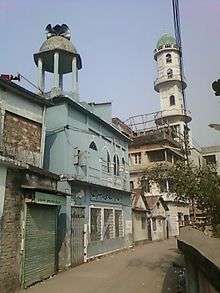Asrafia Jame Mosque
| Asrafia Jame Masjid | |
|---|---|
| আশরাফিয়া জামে মাসজিদ | |
 The front view of Asrafia Jame Masjid | |
| Basic information | |
| Location | Amlapara, Narayanganj, Bangladesh |
| Geographic coordinates | 23°37′20″N 90°30′13″E / 23.6223°N 90.5035°E |
| Affiliation | Hanafi |
| Architectural description | |
| Architectural style | Mughal Architecture |
| Completed | 1890 |
Asrafia Jame Masjid is a Masjid located at Amlapara area at Narayanganj district in Bangladesh which was built under the period of British Raj in around 1890.
History
Asrafia Jame Masjid is one of the oldest Masjid in Narayanganj District in Bangladesh. In the British Raj period, Zamindar Rohim Boksh Haji and His Wife Talukdar Alladi BiBi who was the owner Of Talluk purchased the land from Narayanganj portion of Baliati Jomidary dated 20 April 1898. Zamindar Rohim Boksh Haji and Taluqdar Alladi BiBi Given to Almighty Allah 01(One)Decimal land which was extended 02(Two)Decimals in next for this Masjid in the Amlapara area. Asrafia Jame Masjid has been found Record in the British map (C S) Parcha.
Architectural elements and style
Although the masjid was built in the British Raj period, the structure followed the prior period Mughal Renovations. It was built as an extremely tall single-storied Masjid with great emphasis of the vertical qualities where the one Mihrab is located in the western wall, stood from the base of the ground floor to one-third the height of the first floor. There are small four domes in the four sides of the roof seems to be part of Mughal Architectural Style which all but jeopardized the structural beauty defined by the relationship between the domes and Minar. Inside of Masjid at western wall upon Mihrab written لا إله إلا الله محمد رسول الله By Calligraphy with Glass and Stone flowing Mughal style . The Design Of Mihrab was made Pieces Of Glass and Minimum Five(05) Colours Precious Stone. The architecture of the Asrafia Jame Masjid is defined by a combination of embellishments and proportional adjustment among elements such as arches, domes, mihrab etc.
References
External links
- Mugal Ancient Mosque Daily Samakal, 25 August 2015
- Ancient Mosque in Bangladesh, Daily Inqilab, 9 July 2015